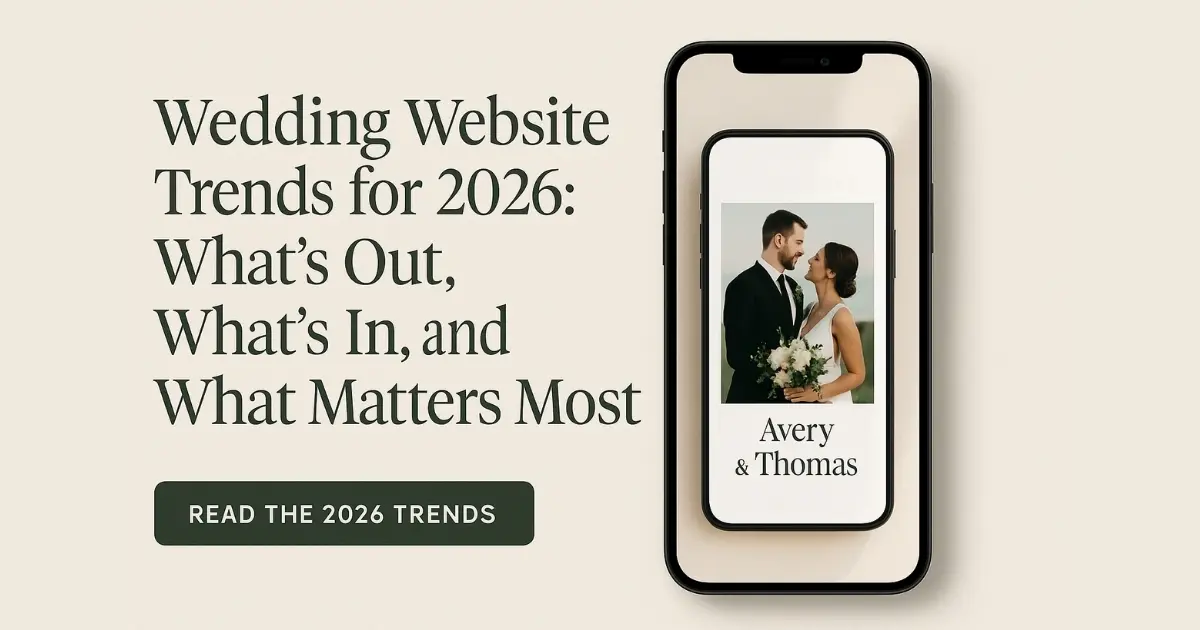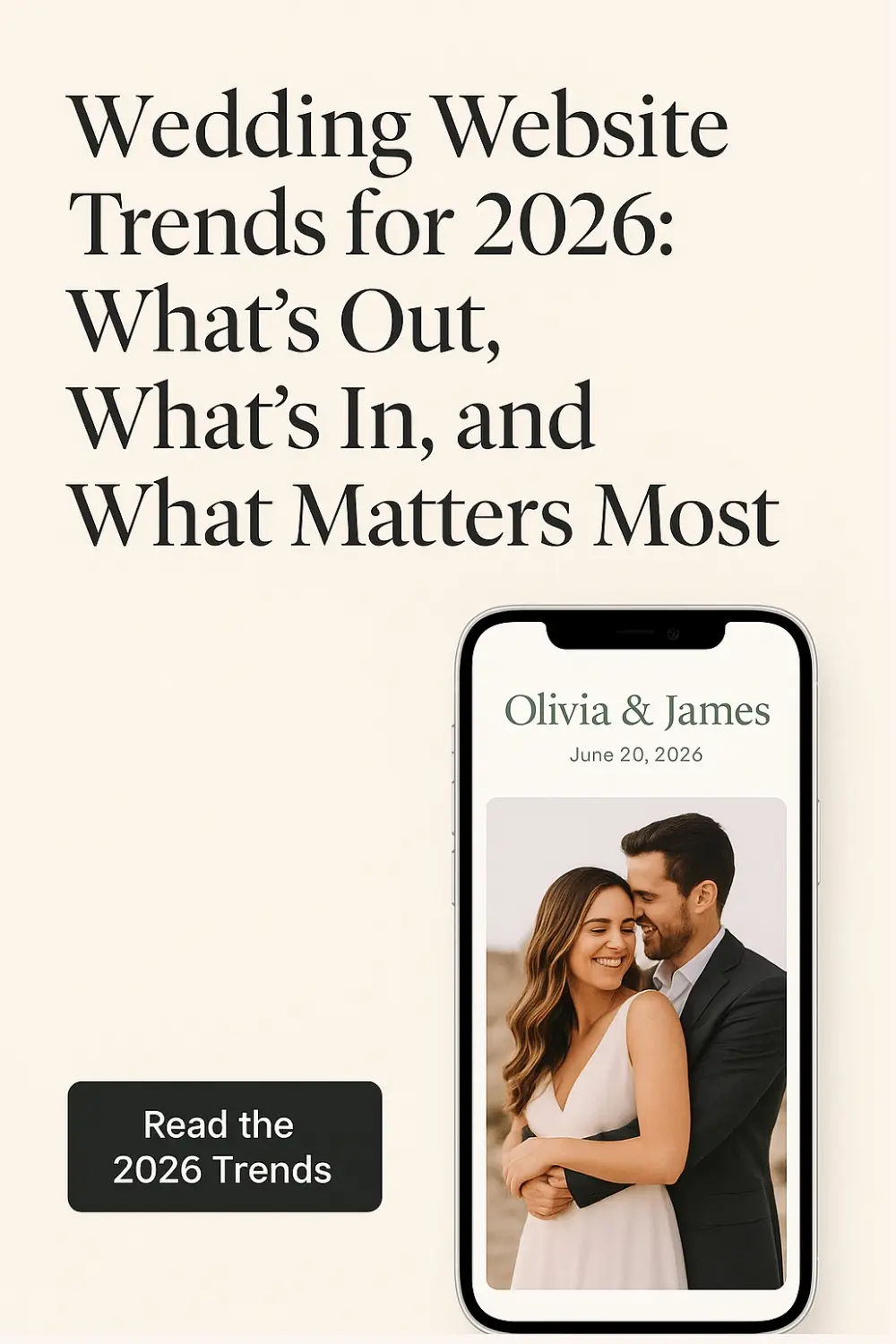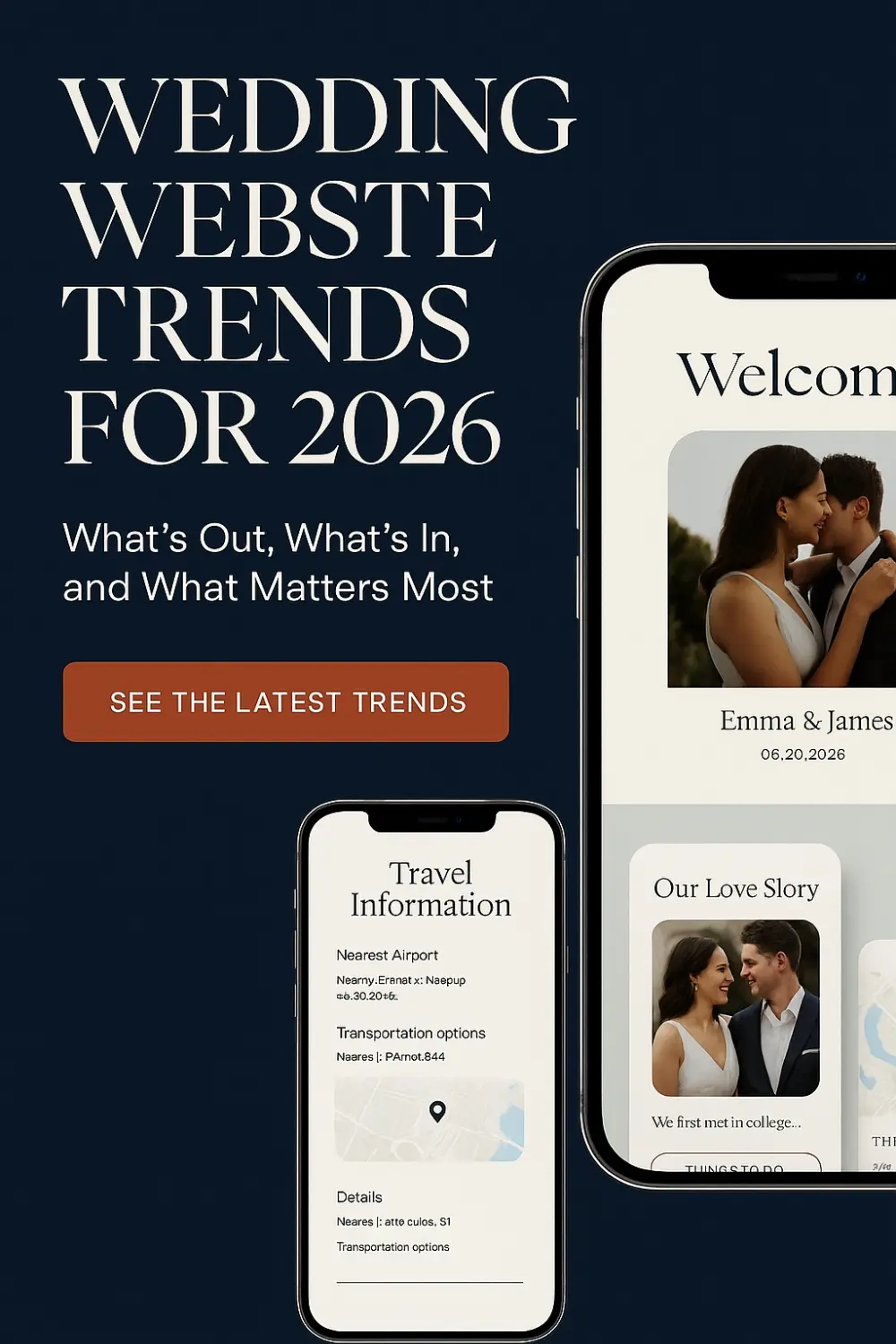
Wedding Website Trends for 2026: What’s Out, What’s In, and What Matters Most
Wedding websites are evolving fast. In 2026, the best sites look and feel like lightweight apps: mobile-first, privacy-forward, accessible to everyone, and designed around real weekend logistics. This guide shows what to skip, what to embrace, and how to build a guest-first experience that reduces questions and planning stress.
Whether you’re hosting an intimate backyard celebration or a destination weekend, your website is the source of truth. The trends below focus on clarity, connection, and comfort for your guests—without adding noise or complexity.
What’s Out in 2026 (Skip These)
- Copy-paste templates: Look-alike layouts that say little about your story or schedule.
- Walls of text: Dense paragraphs slow guests down and create confusion.
- Clunky RSVP forms: Paper replies and outdated fields that don’t adapt to the guest.
- “Set it and forget it” sites: Plans shift; your website must update quickly and visibly.
- Weak privacy: Public addresses, hotel blocks, and guest lists are a no.
- Accessibility as an afterthought: Low contrast, tiny type, and unlabeled images exclude guests.
What’s In for 2026 (Use These)
Trends only matter when they make your celebration clearer and more comfortable. These do.
1) Mobile-First, App-Like UX
Most guests will only ever visit on a phone. Prioritize one-tap actions (RSVP, directions, add to calendar), sticky navigation, large tap targets, and swipeable galleries. Keep your homepage focused on what guests need to act on.
- Place your RSVP button above the fold.
- Use short, scannable event cards rather than long paragraphs.
- Test on multiple phones, not just yours.
2) Privacy-Forward Details
Gate addresses, hotel blocks, and shuttle info behind a password or guest code. Share the code on save-the-dates or invitations so access is effortless for invited guests and invisible to search engines. Learn more in Wedding Website Privacy in 2025.
3) Accessibility by Design
Accessible sites are kind and effective. Use readable type sizes, strong color contrast, descriptive link labels, and alt text for images. Ensure keyboard-friendly navigation and avoid text baked into images.
- Add alt text such as “Outdoor ceremony at sunset with mountain backdrop.”
- Use headings and lists for structure and scanning.
- Write link text that describes the action (e.g., “View weekend schedule”).
4) Intent-Based RSVPs (Beyond Yes/No)
Great RSVP flows adapt to the guest. If a plus-one is invited, ask for their name and meal. If a child is attending, reveal kid-friendly options. Collect only what you’ll use. For setup tips, read Digital RSVPs That Work in 2025.
5) Weekend & Destination-Ready Schedules
Real weddings span multiple days: welcome drinks, ceremony, reception, and brunch. Present a day-by-day schedule with time windows, addresses, dress codes, and “who’s invited” notes. Allow guests to filter by Everyone, Family, or Wedding Party. For timing, see Wedding Website Timeline.
6) Multilingual & Cultural Clarity
Offer key details in a second language when appropriate. Add short ceremony primers (“what to expect,” “when to cheer,” “what to wear”) so guests feel confident and included—especially for cross-cultural celebrations.
7) Eco-Friendly Swaps: QR Cards & Digital Programs
Use your website to replace reprints and reduce waste. QR codes on signage can open your live schedule, menu, or seating details. Guests always have the latest information without another PDF in their inbox.
8) Travel & Logistics That Reduce Group-Chat Chaos
Spell out airport codes, rideshare zones, parking pins, shuttle windows, and local tips. Add “Add to Calendar” and map links directly from each event. If logistics feel heavy, start here: How to Share Wedding Info with Guests.
9) Smart Reminders & Live Updates
Weather shift? New shuttle time? Post a banner on your homepage and send an email or text with a link back to the site. Guests learn that your website is the single, current source of truth. For sharing strategies, see Sharing Your Wedding Website (The Right Way).
10) Clean, Minimal Aesthetics — With Personality
Embrace generous spacing, a restrained palette with one accent color, and consistent cards for events and FAQs. Let personality show through language, photography, and micro-interactions—not visual clutter.
Design Direction for 2026
- Color: Oat, stone, and dove neutrals with a single accent (sage, terracotta, or midnight) reserved for CTAs and headers.
- Type: Editorial serif for headlines; clean sans serif for body text.
- Layout: Grid sections, sticky nav, large buttons, and scannable cards for events and FAQs.
- Imagery: Choose a few strong photos over many small ones; compress images and write alt text.
Principles: What Matters Most
- Clarity beats cleverness: Date, time, location, attire, and RSVP must be obvious.
- Connection is the point: Warm, concise storytelling invites guests in.
- Respect time and data: Short forms, private links, and explicit instructions build trust.
- Accessibility is essential: Design so everyone can participate fully.
- Updates keep promises: If plans change, your site shows it first.
10-Step Checklist to Make Your Site 2026-Ready
- Open on a phone—RSVP and directions should be one tap away.
- Rewrite event info into short, labeled blocks guests can scan.
- Create a weekend schedule with addresses, attire, and “who’s invited.”
- Turn on password protection or guest codes for private details.
- Enable intent-based RSVPs (plus-ones, kids, dietary notes).
- Add alt text; increase font sizes and color contrast for readability.
- Translate essential pages or add a bilingual summary if needed.
- Use QR codes for live schedule, menus, and maps.
- Embed maps and add “Add to Calendar” buttons to key events.
- Plan your update flow: homepage banner + email/text notice with link back.
Build Faster with Weddnesday
Weddnesday’s guest-friendly templates, intent-based RSVPs, privacy controls, and clean design help you launch quickly and confidently. Explore Modern Features, confirm essentials with the Wedding Website Checklist, avoid pitfalls with Common Wedding Website Mistakes, and share like a pro using these tips.
FAQ
Do I really need password protection?
Yes, if you’re posting addresses, hotel blocks, shuttles, or guest lists. A simple code keeps details off search engines while staying easy for guests.
How early should I launch?
As soon as you’ve booked the venue and set the date—then update in phases as details firm up. See the Wedding Website Timeline.
What belongs on the 2026 homepage?
Names, date, city/venue, a clear RSVP button, and a visible link to the weekend schedule. Keep it uncluttered.
How can I reduce guest questions?
Add a concise FAQ covering attire, parking, childcare, gifts/registry, and social-media preferences. Link your site in save-the-dates and reminders.
Save These Guides for Later
Wedding Website Timeline Guide
Sharing Your Website (The Right Way)
How to Keep Your Info Secure
Stay Connected
Follow Weddnesday for weekly planning tips, trends, and real wedding inspiration:
Pinterest | Instagram | Facebook | LinkedIn
Join the conversation on LinkedIn.

